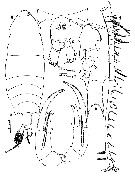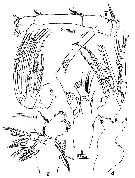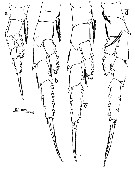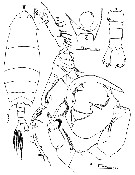|
|
 |
|
Calanoida ( Order ) |
|
|
|
Diaptomoidea ( Superfamily ) |
|
|
|
Pontellidae ( Family ) |
|
|
|
Pontella ( Genus ) |
|
|
| |
Pontella papuaensis Mulyadi, 2014 (F,M) | |
| | | | | | | Ref.: | | | Mulyadi, 2014 (p.1631, Descr. F, M, figs.F, M, Rem.) |  Issued from : Mulyadi in Crustaceana, 2014, 87 (14). [p.1633, Fig.5] Female (from Arguni Bay, Kaimana, W Papua): a, habitus (dorsal); b, pedigerous somite 5 and urosome (lateral); c, same (ventral); d, A1; e, rostrum (frontal view); f, P5 (L = left leg; R = right leg). Nota: - Cephalosome and pedigerous somite 1 separated, 4th and 5th pedigerous somites separated. - Cephalon with a pair of lateral hooks. - Cephalon with pair of small lenses located anteriorly. - rostrum without lens, basal portion extended ventrally roughly to level of ventral rye and divided distally into 2 short spiniform processes
- Urosome with 2 somites.
- Genital double-somite much larger than anal somite, asymmetrical, right side more convex than left side, directed dorsocaudally and tapering into blunt tip reaching as far as 1/4 length of right caudal ramus. Genital operculum withot any processes.
- Anal somite wider than long, asymmetrical, right side longer than left.
- Caudal rami very asymmetrical, right ramus being longer and broader, inner margin of each ramus fringede with fine hairs; each ramus with 5 long plumose and 1 small setae.
- A1 22-segmented, symmetrical; posterior margin of segments 2-13 fringed with fine hairs.
|
 Issued from : Mulyadi in Crustaceana, 2014, 87 (14). [p.1634, Fig.6] Female: a, A2; b, Md palp; c, Mx1; d, Md gnathobase; e, Mx2; f, Mxp. Nota: - Md blade heavily chitinized, 7 teeth and spinulosa seta on cutting edge; both 3rd and 4th dorsalmost teeth bicuspidate; ''dagger like'' spines present at base of teeth 3-7; Md palpus with endopod 2-segmented, exopod 5-segmented. - Mx1: gnathobase (arthrite) with 16 stout setae, minute spinules and fine hairs near base of stout setae; 2nd inner lobe with 3 setae of unequal length; 3rd inner lobe with 1 long and 3 short setae of sub-equal length; 1st outer lobe with 9 setae; 2nd outer lobe rudimentary with single seta; base with long hairs on inner basal half, 4 medial setae, 4 sub-apical setae, and 5 apical setae; endopod completely fused with basis; exopod with 10 setae and small setula. - Mx2 with 6 inner lobes on basal segment; lobes 4-6 carrying 2, 1 and 1 strong setae, respectively, each with row of setulae arranged at right angles to its inner margin and distal end serrated; endopod 3-segmented, 1st segment with only single strong seta, 2nd with setula and stron seta, 3rd segment with 3 strong setae, 1 being serrate along inner margin. Mxp reduced in size; coxa with 3 groups of setae, consisting of 2, 3 and 3 setae, respectively, distal part produced distally covering basal part od basis; anterior margin of basis fringed with row of small teeth and small setula subdistally and 2 plumose setae distally; endopod 5-segmented.
|
 Issued from : Mulyadi in Crustaceana, 2014, 87 (14). [p.1635, Fig.7] Female: a-d, P1 to P4.
|
 Issued from : Mulyadi in Crustaceana, 2014, 87 (14). [p.1636, Table III] Female & Male: Seta and spine of the four anterior pairs of legs in Pontella papuaensis.
|
 Issued from : Mulyadi in Crustaceana, 2014, 87 (14). [p.1637, Fig.8]. Male: a, habitus (dorsal); b, urosome (dorsal); c, right A1; d, rostrum (frontal view); e, P5 (anterior). Nota: - Cephalosome and pedigerous somite 1 separated, 4th and 5th separated. - Last thoracic segment produced into slightly asymmetrical, acuminate lobes, reaching posterior end of genital somite. - Pair of cephalic hooks. - Rostrum bulbous with bifid, short conical projections, anterior and posterior sides with 2 well-developed lenses (absent in female). - Urosome of 5 somites. - Genital somite somewhat asymmetrical, left side more swollen than right. - Urosomite 3 longer than following 2 somites combined; - Caudal rami symmetrical, rather elongated with 5 plumose and 1 small setae. - Right A1 geniculate; segment 14 with stout, elongated spine and claw-like at apex; anterior margin from distal end of segment 16 to 0.7 length of segment 18 with toothed ridge of fine denticles; fused segments 19-21 provided with short spur distally and 2 toothed plates, proximal plate with acuminate teeth and distal one with lamelliform teeth; arrangement of setae and proportional length of segments as shown in fig. 8c. Left A1 as in female. - P5 uniramous, asymmetrical; right exopodal segment 1 (chela) more or less rectangular, with bilobated thumb at proximal end of outer margin, both lobes unequal, proximal one stout and lo,g, straight, inner thumb short and spine-like; outer margin distal to thumb concave with 1 large digiting process arising perpendicular to concave surface, 1 plumose seta present at 1/3 length of chela from outer margin; finger of chela elongated, almost as long as left leg, curved outwards about 180° at middle point and ending in spatulate structure with 1 small spine at apex, 3 setae present along concave face, 1 near base of finger, 1 at middle point and 1 near distal end/ Left leg: basis short with 1 plumose seta on inner margin; exopodal segment 1 with 1 distolateral spine; exopodal segment 2 (terminal segment) bulb-shaped, apex with 3 unequal round-tipped spines and 1 long flagellar process, inner margin of exopodal segment 2 hirsute.
| | | | | NZ: | 1 | | |
|
Distribution map of Pontella papuaensis by geographical zones
|
| | | | Loc: | | | Arguni Bay, kaiman, W Papua.
type locality: 03° S, 133°53'11'' E. | | | | N: | 1 | | | | Lg.: | | | (1218) F: 2,88-2,82; M: 2,86-2,84; {f: 2,82-2,88; M: 2,84-2,86} | | | | Rem.: | After Mulyadi (2014, p.1638) the female resembles that of P. danae Giesbrecht, 1889. The author establishes a 5th Pontella species-Group, consisting of a single species (P. papuaensis): P. papuaensis- Group.
| | | Last update : 17/03/2018 | |
|
|
 Any use of this site for a publication will be mentioned with the following reference : Any use of this site for a publication will be mentioned with the following reference :
Razouls C., Desreumaux N., Kouwenberg J. and de Bovée F., 2005-2025. - Biodiversity of Marine Planktonic Copepods (morphology, geographical distribution and biological data). Sorbonne University, CNRS. Available at http://copepodes.obs-banyuls.fr/en [Accessed December 29, 2025] © copyright 2005-2025 Sorbonne University, CNRS
|
|
 |
 |







